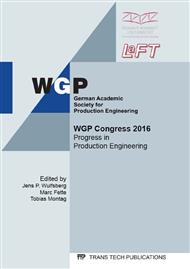[1]
Schuh, G., Schöning, S., Lenders, M., Kubosch, A., Lean Innovation: Idealtypisches Management von Innovationsprozessen in der Investitionsgüterindustrie. In: Ronald Gleich (Eds. ): Innovationsmanagement in der Investitionsgüterindustrie treffsicher voranbringen. Konzepte und Lösungen. Frankfurt am Main: VDMA-Verl., 2006, p.186.
Google Scholar
[2]
De Weck, O. L., Suh, E. S. and Chang, D., Product Family and Platform Portfolio Optimization. Freeman, D.F. 2011. A product family design methodology employing pattern recognition, (2003).
DOI: 10.1115/detc2003/dac-48721
Google Scholar
[3]
Jiao, J. R., Simpson, T. W. and Siddique, Z., Product Family Design and Platform-based Product Development: A State-of-the-art Review, (2007).
Google Scholar
[4]
Simpson, T. W., Jiao, J. R., Siddique, Z., and Hölttä-Otto, K., Advances in Product Family and Product Platform Design: Methods & Applications, (2014).
DOI: 10.1007/978-1-4614-7937-6
Google Scholar
[5]
Simpson, T. W., Maier, J. R. A. and Mistree, F., A Product Platform Concept Exploration Method for Product Family Design, In: ASME Design Engineering Technical Conferences, Las Vegas, (1999).
DOI: 10.1115/detc99/dtm-8761
Google Scholar
[6]
Tucker, C., Kim, H., Barker, D. and Zhang, Y., A Relief attribute weighting and X-means clustering metholody for top-down product family optimization. In: Engineering Optimization, 42(7) (2010) 593-616.
DOI: 10.1080/03052150903353328
Google Scholar
[7]
Moon, S. K., Kumara, S. R. T. and Simpson, T. W., Data Mining and Fuzzy Clustering to Support Product Family Design. In: Proceedings of DETC 06, 2006 ASME Design Engineering Technical Conferences, Philadelphia, 2006, pp.241-246.
DOI: 10.1115/detc2006-99287
Google Scholar
[8]
Freeman, D., Lim, D., Garcia, E. and Mavris, D., Identification of Product Family Platforms Using Pattern Recognition. In: ASME Design Engineering Technical Conferences & Computers and Information in Engineering Conference, Washington, 2011, pp.1027-1039.
DOI: 10.1115/detc2011-47472
Google Scholar
[9]
Ben-Arieh, D., Easton, T., Choubey, A. M., Solving the multiple platforms configuration problem. In: International journal of production research 47(7) (2009) 1969–(1988).
DOI: 10.1080/00207540701561520
Google Scholar
[10]
Seepersad, C. C., Hernandez, G. and Allen, J. K., A Quantitative Approach to Determining Product Platform Extent, (2000).
DOI: 10.1115/detc2000/dac-14288
Google Scholar
[11]
Van den Broeke, M., Boute, R. & Samii, B., Evaluation of product-platform decisions based on total supply chain costs, (2015).
DOI: 10.1080/00207543.2015.1034329
Google Scholar
[12]
Kissel, M., Mustererkennung in komplexen Produktportfolios. München: Universitäts-bibliothek der TU München, (2014).
Google Scholar
[13]
Jonas, H., Gebhardt, N., Krause, D., Towards a Strategic Development of Modular Product Programs. In: International Design Conference - Design 2012, Dubrovnik, 2012, pp.959-968.
Google Scholar
[14]
Zhang, L. L., A literature review on multitype platform and framework for future research. In: Int. J. Production Economics 168 (2015) 1-125.
Google Scholar
[15]
M. Riesener, Ähnlichkeitsbasierte Produktkonfiguration im Maschinenbau, Ph.D. dissertation, RWTH Aachen, Aachen, Germany, (2015).
Google Scholar
[16]
Albers, S., Optimale Auswahl von Produkteigenschaften. In: Albers, S., Herrmann, A. (Eds. ): Handbuch Produktmanagement: Gabler Verlag, 2007, pp.363-394.
DOI: 10.1007/978-3-8349-9517-9_16
Google Scholar
[17]
G. Schuh, S. Rudolf, C. Ortlieb, Portfolio structuring – Determining the optimal number and scope of product platforms, in ISPIM Innovation Summit, Brisbane, Australia, (2015).
Google Scholar
[18]
Feldhusen, J., Grote, K. -H., Pahl/Beitz Konstruktionslehre, 8. Aufl., Berlin, Heidelberg: Springer-Verl, (2013).
Google Scholar
[19]
Ehrlenspiel, K., Integrierte Produktentwicklung. München: Carl Hanser Verlag, fourth ed., (2009).
Google Scholar
[20]
Gaag, A., Entwicklung einer Ontologie zur funktionsorientierten Lösungssuche in der Produktentwicklung, München: Dr. Hut, (2010).
Google Scholar
[21]
Ester, M., Sander, J., Knowledge Discovery in Databases - Techniken und Anwendungen, Berlin: Springer-Verl., (2000).
Google Scholar
[22]
Fayyad, U. M. Piatetsky-Shapiro, G. Smyth, P., Advances in Knowledge Discovery and Data Mining. In: AI Magazine. 17, Nr. 3 (1996) 37–54.
Google Scholar


